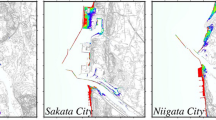Abstract
Cocos Bay is a barrier beach under threat of marine erosion from the high energy environment of the Atlantic Ocean. This barrier beach borders the Ramsar listed Nariva Swamp, and helps maintain its delicate wetland ecosystem, however, ongoing coastal erosion at this beach threatens the longevity of this freshwater wetland. Due to the geographical location of Cocos Bay being exposed to Atlantic generated storm events and the low relief of the study area, there is a potential threat of storm surges breaching the barrier beach. Owing to the geological setting of the region (located in an active seismic province with earthquakes, volcanicity and landslides), there also exists the threat of tsunamis. This paper is a GIS simulation of the area extent of inundation and the affected infrastructure from such events. It utilizes a DEM and land-use to quantifying inundation areas, and the extent of vulnerability of various elements. The low relief of the barrier beach renders the area extremely vulnerable from events that trigger sea level increases. Simulations revealed that as little as a 1 m storm surge has the potential to disrupt the Nariva Swamp and threaten coastal infrastructure while higher storm surges and tsunamis have the potential to decimate the entire area. The flood-risk model generated indicates a very high vulnerability to storm surges, along the entire length of the coastline. These results have implications for future development and sustainable management of this ecologically sensitive area.










Similar content being viewed by others
References
Andel V (1967) The Orinoco delta. J Sediment Petrol 37(2):297–310
Bacon PR, Kenny J, Alkins M, Mootoosingh S, Ramcharan E, Seeberan G (1979) Nariva Swamp Development Project: Studies on the biological resources of Nariva Swamp, Trinidad. Occasional Papers No. 4. St. Augustine, Trinidad: University of the West Indies
Balica SF, Douben N, Wright NG (2009) Flood vulnerability indices at varying spatial scales. Water Sci Technol J 60(10):2571–2580, ISSN 0273–1223
Bertrand D, O’Brien-Delpesh C, Gerald L, Romano H (1992) Coastlines of Trinidad and Tobago. A coastal stability perspective. Institute of Marine Affairs, Hilltop Lane, Chaguaramas
Bird E (2008) Coastal geomorphology: An introduction. Sussex: John Wiley and Sons Ltd
Boer JG, Stouffer RJ, Dix M, Noda A, Senior CA, Raper S, Yap KS (2001) IPCC third assessment report - climate change 2001, Chpt. 9: projections of climate change
Cambers G (1998) Coping with beach erosion. With case studies from the Caribbean. Coastal management sourcebooks 1. UNESCO Publishing, Paris, pp 13–17
Darsan J (2005) A comparative study of the coastal geomorphology of Cocos Bay and Las Cuevas Bay, Trinidad. Caribb Geogr 14(2):116–132
Deutsch CJ, Self-Sullivan C, Mignucci-Giannoni A (2008) Trichechus manatus. In: IUCN 2012. IUCN Red List of Threatened Species. Version 2012.2. <www.iucnredlist.org>. Last accessed: 26/02/2013
Environmental Management Authority (2001) Background paper: climate change vulnerability assessment for Nariva Swamp. Port of Spain
Frazier TG, Wood N, Yarnal B, Bauer DH (2010) Influence of potential sea level rise on societal vulnerability to hurrincane storm-surge hazards, Sarasota County, Florida. Appl Geogr 30(4):490–505
Georges C (1983) A coastal classification for Trinidad. Institute of Marine Affairs, Trinidad & Tobago
Gornitz V (1990) Vulnerability of the East Coast, USA to future sea level rise. J Coast Res 1(Special Issue No. 9):201–237
Hudson D (1988) Recent sedimentation patterns in Trinidad and Tobago. Institute of Marine Affairs, Hilltop Lane, Chaguaramas
Institute of Marine Affairs (1998) Environmental impact assessment of the Nariva Swamp (Biche Bois Neuf Area) Draft Final Report. Ministry of Agriculture, Lands and Marine Resources, Trinidad
Kenny JS (2008) The biological diversity of Trinidad and Tobago: a naturalist’s NIHERST: Prospect Press
Kleinosky LR, Yarnal B, Fisher A (2006) Vulnerability of Hampton roads, Virginia to storm-surge flooding and sea-level rise. Nat Hazard 40(1):43–70
Lynch L (2007) Reducing tsunami risk in the Eastern Caribbean. Seismic Research Unit, The University of the West Indies
Singh B (1997) Climate-related global changes in the southern Caribbean: Trinidad and Tobago. Global Planet Change 15:93–111
Weber JC, Saleh J, Balkaransingh S, Dixon T, Ambeh W, Leong T, Rodriques A, Miller K (2009) Triangulation to GPS and GPS to GPS geodesy in Trinidad, West Indies: Neotectonics, seismic risk, and geologic implications. Mar Pet Geol 1:12
Webster TL, Forbes DL, Dickie S, Shreenan R (2004) Using topogrpahic lidar to map flood risk from storm-surge events for Charlottetown Prince Edward Island, Canada. Can J Remote Sens 30(1):67–76
Webster TL, Forbes DL, MacKinnon E, Roberts D (2006) Flood-risk mapping for storm-surge events and sea-level rise using lidar for southeast New Brunswick. Can J Remote Sens 32(2):194–211
Williams P (2000) Station descriptions for cross-sections along the east coast of Trinidad. In: NEDECO and Delft Hydraulics (ed) Feasibility study and detailed design for coastal protection works, Trinidad. Government of Trinidad and Tobago Ministry of Works and Transportation Drainage Division, Trinidad
Author information
Authors and Affiliations
Corresponding author
Rights and permissions
About this article
Cite this article
Darsan, J., Asmath, H. & Jehu, A. Flood-risk mapping for storm surge and tsunami at Cocos Bay (Manzanilla), Trinidad. J Coast Conserv 17, 679–689 (2013). https://doi.org/10.1007/s11852-013-0276-x
Received:
Revised:
Accepted:
Published:
Issue Date:
DOI: https://doi.org/10.1007/s11852-013-0276-x




